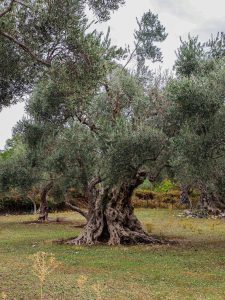 The Ancient Olive Tree: A Symbol of Greek Culture
The Ancient Olive Tree: A Symbol of Greek Culture
The ancient olive tree holds a special place in Greek culture and the landscape of Crete. Revered not only for its rich symbolism but also for its practical value, this remarkable tree has stood for centuries. It embodies wisdom, strength, and peace, forming an intrinsic connection between the land and its people. Moreover, it symbolizes continuity, representing the lasting bond between the island’s traditions and the present day.
Olive Tree in Crete: A Legacy That Spans Millennia
In Crete, the largest Greek island, ancient olive trees have flourished for millennia. These majestic trees adorn the island’s landscape, many of which are believed to be over 2,000 years old. For instance, the Olive Tree of Vouves, located in western Crete, is widely revered as one of the oldest olive trees in the world. This extraordinary tree stands as a living monument to history, demonstrating nature’s resilience and longevity.
Ancient olive trees do more than just represent history—they serve as living witnesses to Crete’s rich heritage. Over the centuries, these trees have provided sustenance, shelter, and livelihoods for generations of Cretans. As a result, they significantly shaped the island’s economy and identity. Moreover, the olive tree has long been at the heart of Cretan culture, symbolizing strength, endurance, and community pride.
Ecological and Cultural Importance of the Olive Tree
Ancient olive trees play a vital role in Crete’s ecosystem. Their deep roots prevent soil erosion, which is especially important in the island’s rocky and often steep terrain. The trees’ expansive canopies provide shade, benefiting other plants and creating a haven for various animals. In doing so, they contribute to a balanced and thriving natural environment. Furthermore, the olives they produce offer an essential food source for local wildlife, including birds and insects. Thus, these trees are fundamental to maintaining the island’s biodiversity and ecological health.
The importance of the olive tree extends beyond environmental benefits. In Greek literature, ancient olive trees symbolize prosperity, peace, and abundance. These trees feature prominently in ancient texts, artwork, and religious ceremonies, reminding us of the enduring relationship between humanity and nature. The olive tree is not only a source of nourishment but also a spiritual emblem of harmony and well-being.
Economic Significance and Cultural Pride
Today, the cultivation of ancient olive trees remains a cornerstone of Crete’s economy. The island continues to produce some of the finest olive oil in the world, celebrated for its purity and exceptional quality. Olive oil production remains central to the island’s economy, providing livelihoods for many families. The olive tree, embodying resilience and strength, serves as a constant source of inspiration for the people of Crete. It continues to foster both economic growth and cultural pride, as Cretans hold their olive oil production in the highest regard.
As we reflect on the importance of the ancient olive tree in Greek culture and the history of Crete, we are reminded of its timeless beauty and lasting legacy. These ancient trees continue to enrich the lives of future generations, preserving the essence of the island’s rich traditions and natural heritage. By honoring the olive tree, the people of Crete ensure that their culture and history remain deeply rooted in the Mediterranean’s fertile soil.
For a deeper connection to the rich heritage of Crete, explore our premium Cretan olive oil collection and experience the timeless quality and tradition that these ancient olive trees have inspired for generations.



